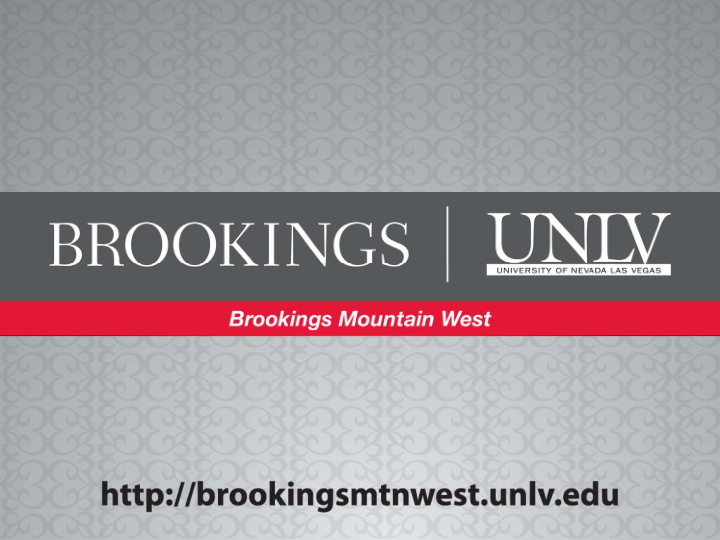



Climate Change and Real Estate: How Environmental Risks and Policies Impact Markets Adele C. Morris, Ph.D. Fellow Policy Director, Climate and Energy Economics Project The Brookings Institution February 25, 2010
2 Themes • Change of some kind is inevitable » through policy or the lack thereof • When and what changes occur, and who experiences them, will depend on what we do and how nature responds. • Hedge your bets.
3 Climate and Property: What are the linkages? • Impacts: Projected climatic disruptions that affect property values • Adaptation: Response of individuals, markets, and policy to climate disruptions • Mitigation: Economic effects of policies to mitigate emissions
4 Climate Change Impacts • Historical • Projected » Emissions scenarios » Climate sensitivity • Location, location, and location
6
7 What is the risk to global temps? Thought experiment: T to 2100, no policy Source: MIT Joint Program on the Science and Policy of Global Change http://globalchange.mit.edu/resources/gamble/no-policy_F.html
8 We buy a better wheel if we stabilize concentrations, e.g. at approx 550 ppmv Source: MIT Joint Program on the Science and Policy of Global Change http://globalchange.mit.edu/resources/gamble/policy_F.html
9 National Impacts: United States • Global Climate Change Impacts in the United States , US government, 2009 Source: GCCIUS www.globalchange.gov
10 National • Climate ‐ related changes are already observed in the United States and its coastal waters. » Heavy downpours, rising temperature and sea level, rapidly retreating glaciers, thawing permafrost, lengthening growing seasons, lengthening ice ‐ free seasons in the ocean and on lakes and rivers, earlier snowmelt, and alterations in river flows. • These changes are projected to grow, especially in a “high emissions” scenario. Source: GCCIUS
11
12 Why are changes bad? • They’re not all bad. • But: • Our built environment fits the climate we’ve had. • The rate of change may be rapid, making it hard for people and ecosystems to adapt.
13 Southwest Regional Predictions • Increasingly scarce water supplies • Increasing temperature, drought, wildfire, and invasive species • Increased frequency and altered timing of flooding • Decreased snow ‐ and water ‐ related tourism and recreation Source: GCCIUS
Projected Temperature Increases in the Southwest Source: GCCIUS
Historical Las Vegas Source: GCCIUS
Projected Precipitation in 2080-99 Relative to 1961-79 Source: GCCIUS
Projected Change in Runoff 2041‐2060 relative to 1901‐1970 Source: GCCIUS
19 Water stress could get worse anyway • The population of the Mountain West (Montana, Idaho, Wyoming, Nevada, Utah, Colorado, Arizona, and New Mexico) is projected to increase 65 % from 2000 to 2030 • This would account for 1/3 of all projected U.S. population growth. Source: GCCIUS
20 Adaptation in the US • Over the long run, most cities will adapt. • People will migrate from uneconomic or unsafe areas to areas more hospitable. » Mean temperature is a poor predictor of per capita income in the US. • US is generally wealthy enough to adapt over many decades. Poorest in US and poor countries are most vulnerable. • Extreme outcomes could overwhelm even US adaptation capacity. • Haven’t considered ecosystems.
Per Capita Income 2002
22 Mitigation: Cap-and-trade • Set total allowable emissions in a given period • Allocate allowances. • Allow trading of allowances. • Require covered entities to hold allowances • Firms cover emissions with allowances unless abating is cheaper.
23 Waxman-Markey, HR 2454 • Passed House in June 2009 • Title 3 is Cap ‐ and ‐ trade • 1418 pages • 17 % reduction in US GHG emissions relative to 2005 by 2020 • 83% reduction by 2050
26 Predicted Electricity Prices with H.R. 2454 (2007 cents per kilowatthour, all sectors average) 20 18 16 14 12 10 8 6 Reference Basic Zero Bank 4 High Offsets High Cost No International No Int / Limited 2 0 2005 2010 2015 2020 2025 2030 Energy Information Administration, US Dept of Energy
27 Regional effects of cap-and-trade • The economic effects of climate policy differ across the country due to different production and consumption patterns of energy and other goods and services. • “Carbon footprint” is an imperfect predictor of which regions are hit relatively harder by policy. • Regional disparities in effects of a carbon price aren’t huge. • Total effects on households depend on details of implementation.
Source: Brown, Southworth, and Sarzynski, “Shrinking the Carbon Footprint of Metropolitan America” (Washington: Brookings Institution, 2008).
Source: Brown, Southworth, and Sarzynski, “Shrinking the Carbon Footprint of Metropolitan America” (Washington: Brookings Institution, 2008).
Source: Brown, Southworth, and Sarzynski, “Shrinking the Carbon Footprint of Metropolitan America” (Washington: Brookings Institution, 2008).
Regional effects of a hypothetical tax of $20.91 per ton of CO2 based on consumption patterns in 2006 Nevada CBO
32 Conclusion • Climate change could make existing problems worse. • Energy bills are likely to go up, either because of climate policy (sooner) or because of a hotter climate (later) or both. • Water likely to be a worsening source of conflict in the southwest. • Energy and water efficiency could be a cost effective hedge against whatever changes emerge.
33
Recommend
More recommend